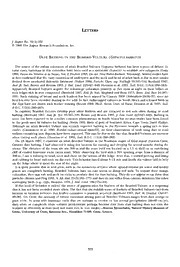
Dust bathing in the bearded vulture (Gypaetus barbatus) PDF
Preview Dust bathing in the bearded vulture (Gypaetus barbatus)
. Letters RaptorRes. 32(4):322 J. © 1998 The Raptor Research Foundation, Inc. Dust Bathing in the Bearded Vulture Gypaetus barbatus) ( The source of the rufous coloration of adult Bearded Vultures {Gypaetus barbatus) has been a point of debate. In some cases, variations in this coloration have been used as a systematic character to establish new subspecies (Fatio 1899, Faune des Vertebres de la Suisse., Vol. 2; Fischer 1963, Die eier. Neue Brehm-Bucherei, Wittenberg. Several studies have in fact confirmed that the rusty coloration ofunderparts and the neck and head of adult birds is due to iron oxides derived from weathered dolomitic limestone (Volker 1960, Fortschr. Chem. org. NatStoffe 18:107-110; Berthold 1967, Zool. Jb. Syst.; Brown and Bruton 1991,/. ZooL Lond. 223:627-640; Houston et al. 1993, Aull. B.O.C. 113(4):260-263) Apparently, Bearded Vultures acquire the red-orange coloration passively as they roost at night on their bellies on rock ledges rich in iron compound (Berthold 1967, Zool. Jb. Syst.] Siegfried and Frost 1973, Bonn. Zool. Beitr. 24:387- 393). Such staining of breast and neck feathers has been argued by Clancey 1968 {Bokmakierie 20:36-37) since no bird has ever been recorded dusting in the wild. In fact, radio-tagged vultures in South Africa and released birds in the Alps have not shown such feather staining (Brown 1988, Ph.D. thesis, Univ. of Natal; Houston et al. 1993, Aull. BO.C. 113(4):260-263). In captivity. Bearded Vultures develop pure white feathers and are attracted to red soils often dusting or mud bathing (Berthold 1967, Zool. Jb. Syst. 93:507-595; Brown and Bruton 1991,/. Zool. Lond. 223:627-640). Bathing in water has been reported to be a rather common phenomenon in South Africa but no iron oxides have been found in the pools used by vultures for bathing (Steyn 1982, Birds of prey of Southern Africa. Cape Town: David Philip). Although an adult Bearded Vulture was recently reported bathing in the Pyrenees beneath a spring rich in iron oxides (Caussimont et al. 1995, Bearded vulture annual report.53), no field observations of birds using dust or mud wallows containing iron deposits have been reported. This may be due to the fact that Bearded Vultures are secretive when visiting such places (Houston et al. 1993, Aull. B.O.C. 113(4):260-263) On 23 March 1997, I observed an adult Bearded Vulture at the Northern slopes of Dikti massif (Eastern Crete, Greece) dust bathing. I had observed it using this location for roosting and sleeping for several months during the m m winter. The elevation of the roost site was 300 and the roost itself was located on a 1.5 shelf on an east-facing cliff of eroded limestone rocks (terra rosa). While observing the bird with a 30X spotting scope from a distance of 300 m, I saw it rubbing its head, neck and chest on the bottom of the ledge. After that, it started pecking and biting and rubbing its head and neck on the rock. This behavior lasted about 8-12 min and finally the vulture laid its belly on the ledge where it spent the rest of the night. It is quite possible that in arid areas, such as the mountains of Crete where upland streams are scarce and muddy places are completely lacking, Bearded Vultures have no easy access to damp red soils. To acquire their orange coloration, they may rub and peck on rocks to produce dust for dust bathing. They do not appear to eat these dust particles (Brown and Plug 1991, S. Afr. Zool. 25(3):169-177) and they do not suffer from calcium deficiencylike other scavenging birds (e.g., Gyps, Houston 1978,/. Zool. Lond. 186:175-184). If this kind of behavior is indeed the source of pigmentation for feathers of the Bearded Vulture, it is surprising that it has not been recorded more often. The fact that the reddish tones of feathers ofBearded Vultures vary from location to location indicates that feather coloration is passively acquired (Berthold 1967, Bull. Br. Ornithol. Club 87: 89-90) On Crete, the intensity of rufous coloration among pairs of Bearded Vultures ranges from dark orange to . pure white. In areas with limestone rocks that are resistant to erosion or low annual precipitation (60-80 cm/yr), dirty white or completely white vultures predominate perhaps because dust from dust bathing does not stain the — feathers as effectively as does mud and water rich in iron oxides. Stavros Xirouchakis, Natural History Museum of Crete, University of Crete, Knossou Ave., Heraklion 71409, Crete, Greece. 322
